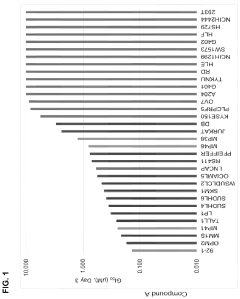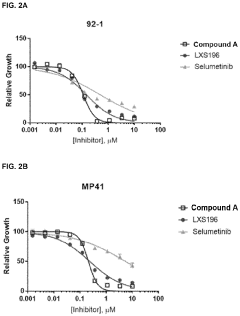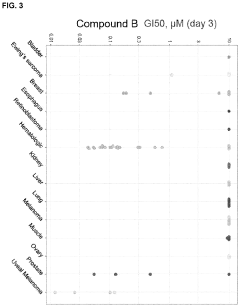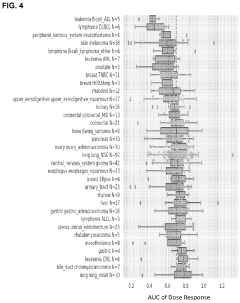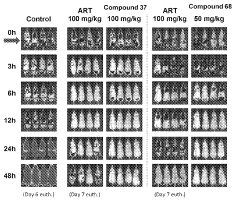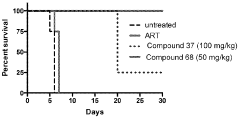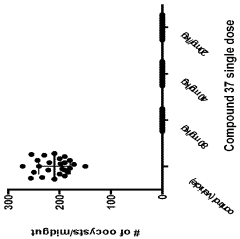Stereochemical Consequences of Geometric Isomers in Polymerization
AUG 1, 20259 MIN READ
Generate Your Research Report Instantly with AI Agent
Patsnap Eureka helps you evaluate technical feasibility & market potential.
Geometric Isomers in Polymer Science: Background and Objectives
Geometric isomers have played a crucial role in the development of polymer science, significantly influencing the properties and applications of polymeric materials. The study of these isomers in polymerization processes has been a cornerstone of research in this field for decades. Geometric isomerism, a form of stereoisomerism, occurs when the spatial arrangement of atoms or groups around a double bond or ring structure differs, leading to distinct molecular configurations.
The evolution of polymer science has been closely tied to the understanding and manipulation of geometric isomers. Early investigations in the mid-20th century focused on identifying the presence of these isomers in synthetic polymers and their impact on material properties. As analytical techniques advanced, researchers gained deeper insights into the stereochemical consequences of geometric isomerism during polymerization reactions.
The primary objective in studying geometric isomers in polymer science is to elucidate their effects on polymer structure, properties, and performance. This includes understanding how different isomeric configurations influence crystallinity, mechanical strength, thermal stability, and other key characteristics of polymeric materials. Additionally, researchers aim to develop methods for controlling the formation and distribution of geometric isomers during polymerization processes.
One of the most significant technological trends in this field has been the development of stereospecific catalysts and polymerization techniques. These advancements have enabled greater control over the stereochemistry of polymer chains, allowing for the production of materials with tailored properties. The ability to manipulate geometric isomers has opened up new possibilities in various applications, from high-performance plastics to advanced biomedical materials.
The study of geometric isomers in polymerization has also contributed to broader scientific understanding. It has provided insights into reaction mechanisms, molecular interactions, and structure-property relationships in polymers. This knowledge has been instrumental in advancing other areas of materials science and chemistry, demonstrating the far-reaching impact of this specialized field of study.
Looking forward, the continued exploration of geometric isomers in polymer science is expected to yield further breakthroughs. Emerging technologies, such as computational modeling and advanced spectroscopic techniques, are poised to provide even deeper insights into the stereochemical aspects of polymerization. These advancements may lead to the development of novel materials with unprecedented properties and functionalities, further expanding the horizons of polymer science and its applications across various industries.
The evolution of polymer science has been closely tied to the understanding and manipulation of geometric isomers. Early investigations in the mid-20th century focused on identifying the presence of these isomers in synthetic polymers and their impact on material properties. As analytical techniques advanced, researchers gained deeper insights into the stereochemical consequences of geometric isomerism during polymerization reactions.
The primary objective in studying geometric isomers in polymer science is to elucidate their effects on polymer structure, properties, and performance. This includes understanding how different isomeric configurations influence crystallinity, mechanical strength, thermal stability, and other key characteristics of polymeric materials. Additionally, researchers aim to develop methods for controlling the formation and distribution of geometric isomers during polymerization processes.
One of the most significant technological trends in this field has been the development of stereospecific catalysts and polymerization techniques. These advancements have enabled greater control over the stereochemistry of polymer chains, allowing for the production of materials with tailored properties. The ability to manipulate geometric isomers has opened up new possibilities in various applications, from high-performance plastics to advanced biomedical materials.
The study of geometric isomers in polymerization has also contributed to broader scientific understanding. It has provided insights into reaction mechanisms, molecular interactions, and structure-property relationships in polymers. This knowledge has been instrumental in advancing other areas of materials science and chemistry, demonstrating the far-reaching impact of this specialized field of study.
Looking forward, the continued exploration of geometric isomers in polymer science is expected to yield further breakthroughs. Emerging technologies, such as computational modeling and advanced spectroscopic techniques, are poised to provide even deeper insights into the stereochemical aspects of polymerization. These advancements may lead to the development of novel materials with unprecedented properties and functionalities, further expanding the horizons of polymer science and its applications across various industries.
Market Analysis of Stereoregular Polymers
The market for stereoregular polymers has experienced significant growth in recent years, driven by their unique properties and diverse applications across various industries. These polymers, characterized by their well-defined spatial arrangement of side groups along the polymer chain, offer superior mechanical, thermal, and optical properties compared to their atactic counterparts.
The global stereoregular polymer market is primarily segmented into isotactic and syndiotactic polymers. Isotactic polypropylene (iPP) dominates the market, accounting for a substantial share due to its widespread use in packaging, automotive, and consumer goods industries. The demand for iPP is expected to continue growing, particularly in emerging economies, as it offers an excellent balance of properties and cost-effectiveness.
Syndiotactic polystyrene (sPS) represents another important segment of the stereoregular polymer market. While its market share is smaller compared to iPP, sPS has found niche applications in electronics, automotive, and medical devices due to its high heat resistance and dimensional stability. The increasing demand for high-performance materials in these sectors is driving the growth of sPS.
The automotive industry is a major consumer of stereoregular polymers, particularly iPP, for interior and exterior components. The trend towards lightweight vehicles for improved fuel efficiency is expected to further boost the demand for these materials. Additionally, the packaging industry continues to be a significant market for stereoregular polymers, especially in food packaging applications where their barrier properties and chemical resistance are highly valued.
Geographically, Asia-Pacific leads the stereoregular polymer market, with China being the largest consumer and producer. The region's robust manufacturing sector, coupled with increasing industrialization and urbanization, is driving the demand for these materials. North America and Europe follow, with mature markets focusing on high-value applications and technological advancements in polymer processing.
The market is characterized by intense competition among key players, including LyondellBasell, Borealis AG, and SABIC. These companies are investing heavily in research and development to improve the properties of stereoregular polymers and expand their application scope. Innovations in catalyst technology and polymerization processes are expected to play a crucial role in shaping the future of this market.
Environmental concerns and sustainability issues pose challenges to the stereoregular polymer market. However, they also present opportunities for innovation in recycling technologies and the development of bio-based alternatives. The industry is increasingly focusing on circular economy principles, which could lead to new market segments and applications for stereoregular polymers in the coming years.
The global stereoregular polymer market is primarily segmented into isotactic and syndiotactic polymers. Isotactic polypropylene (iPP) dominates the market, accounting for a substantial share due to its widespread use in packaging, automotive, and consumer goods industries. The demand for iPP is expected to continue growing, particularly in emerging economies, as it offers an excellent balance of properties and cost-effectiveness.
Syndiotactic polystyrene (sPS) represents another important segment of the stereoregular polymer market. While its market share is smaller compared to iPP, sPS has found niche applications in electronics, automotive, and medical devices due to its high heat resistance and dimensional stability. The increasing demand for high-performance materials in these sectors is driving the growth of sPS.
The automotive industry is a major consumer of stereoregular polymers, particularly iPP, for interior and exterior components. The trend towards lightweight vehicles for improved fuel efficiency is expected to further boost the demand for these materials. Additionally, the packaging industry continues to be a significant market for stereoregular polymers, especially in food packaging applications where their barrier properties and chemical resistance are highly valued.
Geographically, Asia-Pacific leads the stereoregular polymer market, with China being the largest consumer and producer. The region's robust manufacturing sector, coupled with increasing industrialization and urbanization, is driving the demand for these materials. North America and Europe follow, with mature markets focusing on high-value applications and technological advancements in polymer processing.
The market is characterized by intense competition among key players, including LyondellBasell, Borealis AG, and SABIC. These companies are investing heavily in research and development to improve the properties of stereoregular polymers and expand their application scope. Innovations in catalyst technology and polymerization processes are expected to play a crucial role in shaping the future of this market.
Environmental concerns and sustainability issues pose challenges to the stereoregular polymer market. However, they also present opportunities for innovation in recycling technologies and the development of bio-based alternatives. The industry is increasingly focusing on circular economy principles, which could lead to new market segments and applications for stereoregular polymers in the coming years.
Current Challenges in Stereochemical Control
The control of stereochemistry in polymerization processes remains a significant challenge in polymer science and engineering. One of the primary difficulties lies in the precise manipulation of geometric isomers during polymerization reactions. These isomers, which possess the same molecular formula but different spatial arrangements of atoms, can significantly impact the final polymer properties.
A major hurdle in stereochemical control is the inherent complexity of polymerization kinetics. The rapid and often unpredictable nature of chain growth makes it challenging to maintain consistent stereochemical configurations throughout the polymer backbone. This is particularly evident in free radical polymerizations, where the high reactivity of propagating radicals can lead to a loss of stereochemical information.
Another critical challenge is the influence of reaction conditions on stereochemistry. Factors such as temperature, pressure, and solvent choice can dramatically affect the stereochemical outcome of polymerization. For instance, higher temperatures often lead to increased chain mobility and reduced stereoselectivity, while certain solvents may preferentially stabilize specific geometric isomers.
The development of stereospecific catalysts presents both opportunities and challenges. While these catalysts offer the potential for precise stereochemical control, their design and optimization remain complex. The need for catalysts that can maintain high activity while also providing excellent stereoselectivity across a range of monomers and reaction conditions is a significant research focus.
Copolymerization introduces additional layers of complexity to stereochemical control. The incorporation of multiple monomer types can lead to sequence-dependent stereochemistry, where the stereochemical outcome at a given site is influenced by the identity and configuration of neighboring units. This phenomenon complicates efforts to predict and control the overall stereochemistry of copolymers.
Post-polymerization modifications aimed at altering stereochemistry face their own set of challenges. These include the difficulty of selectively targeting specific sites along the polymer chain and the potential for unintended side reactions that may compromise the polymer's integrity or desired properties.
Lastly, the characterization and quantification of stereochemical information in polymers remain technically demanding. While techniques such as NMR spectroscopy and X-ray diffraction provide valuable insights, the development of more sensitive and high-throughput methods for stereochemical analysis is an ongoing area of research.
A major hurdle in stereochemical control is the inherent complexity of polymerization kinetics. The rapid and often unpredictable nature of chain growth makes it challenging to maintain consistent stereochemical configurations throughout the polymer backbone. This is particularly evident in free radical polymerizations, where the high reactivity of propagating radicals can lead to a loss of stereochemical information.
Another critical challenge is the influence of reaction conditions on stereochemistry. Factors such as temperature, pressure, and solvent choice can dramatically affect the stereochemical outcome of polymerization. For instance, higher temperatures often lead to increased chain mobility and reduced stereoselectivity, while certain solvents may preferentially stabilize specific geometric isomers.
The development of stereospecific catalysts presents both opportunities and challenges. While these catalysts offer the potential for precise stereochemical control, their design and optimization remain complex. The need for catalysts that can maintain high activity while also providing excellent stereoselectivity across a range of monomers and reaction conditions is a significant research focus.
Copolymerization introduces additional layers of complexity to stereochemical control. The incorporation of multiple monomer types can lead to sequence-dependent stereochemistry, where the stereochemical outcome at a given site is influenced by the identity and configuration of neighboring units. This phenomenon complicates efforts to predict and control the overall stereochemistry of copolymers.
Post-polymerization modifications aimed at altering stereochemistry face their own set of challenges. These include the difficulty of selectively targeting specific sites along the polymer chain and the potential for unintended side reactions that may compromise the polymer's integrity or desired properties.
Lastly, the characterization and quantification of stereochemical information in polymers remain technically demanding. While techniques such as NMR spectroscopy and X-ray diffraction provide valuable insights, the development of more sensitive and high-throughput methods for stereochemical analysis is an ongoing area of research.
Existing Strategies for Stereochemical Regulation
01 Stereochemical consequences of geometric isomerism
Geometric isomers have different spatial arrangements of atoms around a double bond or in a ring, leading to distinct stereochemical properties. These differences can affect molecular shape, reactivity, and biological activity. Understanding these consequences is crucial in fields such as organic synthesis, drug design, and materials science.- Structural differences in geometric isomers: Geometric isomers have the same molecular formula but different spatial arrangements of atoms. These structural differences can lead to distinct physical and chemical properties, affecting their reactivity, melting points, and biological activities. Understanding these differences is crucial in various fields, including organic synthesis and drug development.
- Stereochemical consequences in reaction mechanisms: The stereochemistry of geometric isomers can significantly influence reaction mechanisms and outcomes. This includes effects on reaction rates, product distributions, and the formation of specific stereoisomers. Researchers study these consequences to optimize synthetic routes and predict reaction behaviors in complex systems.
- Analytical methods for geometric isomer identification: Various analytical techniques are employed to identify and characterize geometric isomers. These methods include spectroscopic techniques like NMR and IR spectroscopy, as well as chromatographic methods. Advanced computational tools and modeling approaches are also used to predict and analyze the stereochemical properties of geometric isomers.
- Applications of geometric isomers in pharmaceuticals: Geometric isomerism plays a crucial role in pharmaceutical development. The stereochemical configuration of drug molecules can significantly affect their efficacy, toxicity, and pharmacokinetics. Researchers explore the stereochemical consequences of geometric isomers to design more effective and safer drugs.
- Industrial processes and geometric isomer control: In industrial settings, controlling the formation and separation of geometric isomers is essential for product quality and process efficiency. This involves developing selective synthetic methods, optimizing reaction conditions, and implementing effective purification techniques to obtain desired isomers with high stereochemical purity.
02 Synthesis and separation of geometric isomers
Developing methods for synthesizing and separating geometric isomers is essential for studying their properties and applications. Techniques such as stereoselective synthesis, chromatography, and crystallization are employed to obtain pure geometric isomers. These methods are crucial for producing isomerically pure compounds for various industrial and pharmaceutical applications.Expand Specific Solutions03 Computational modeling of geometric isomers
Advanced computational techniques are used to model and predict the properties of geometric isomers. These methods help in understanding the energetics, conformational preferences, and reactivity of different isomers. Computational modeling aids in the design of new molecules with desired stereochemical properties and in predicting the behavior of existing compounds.Expand Specific Solutions04 Applications of geometric isomers in pharmaceuticals
Geometric isomerism plays a crucial role in pharmaceutical development. Different geometric isomers of a drug molecule can exhibit varying biological activities, efficacies, and side effects. Understanding and controlling the stereochemistry of drug candidates is essential for optimizing their therapeutic properties and minimizing unwanted effects.Expand Specific Solutions05 Industrial applications of geometric isomers
Geometric isomers find applications in various industries beyond pharmaceuticals. They are used in the production of polymers, agrochemicals, and advanced materials. The specific stereochemistry of these isomers can influence properties such as thermal stability, optical characteristics, and mechanical strength, making them valuable in diverse industrial processes and products.Expand Specific Solutions
Key Players in Stereocontrolled Polymer Synthesis
The field of stereochemical consequences in polymerization is in a mature stage of development, with significant market potential due to its applications in pharmaceutical and materials industries. The global market for stereospecific polymers is estimated to be in the billions, driven by demand for high-performance materials. Technologically, companies like Pfizer, Novartis, and Roche Diagnostics are at the forefront, leveraging advanced analytical techniques and computational modeling to optimize stereochemical control in polymerization processes. Academic institutions such as the University of Pennsylvania and North Carolina State University contribute fundamental research, while specialized firms like Foghorn Therapeutics and Chronos Therapeutics focus on novel applications in drug discovery and development.
Pfizer Inc.
Technical Solution: Pfizer has developed advanced stereoselective polymerization techniques to control the stereochemistry of polymers. Their approach involves using chiral catalysts and ligands to promote the formation of specific geometric isomers during polymerization[1]. This allows for precise control over the tacticity and configuration of polymer chains, resulting in materials with enhanced properties. Pfizer's method includes the use of metallocene catalysts with C2-symmetric ligands, which can produce highly isotactic or syndiotactic polymers depending on the catalyst structure[2]. They have also implemented post-polymerization modification techniques to further manipulate the stereochemistry of existing polymers[3].
Strengths: Precise control over polymer stereochemistry, ability to tailor material properties. Weaknesses: Complex and potentially costly catalyst systems, may be limited to certain monomer types.
SABIC Global Technologies BV
Technical Solution: SABIC has pioneered a novel approach to addressing geometric isomerism in polymerization through their proprietary "Isomer-Selective Catalysis" (ISC) technology. This method utilizes specially designed metal-organic frameworks (MOFs) as catalysts, which can discriminate between cis and trans isomers during polymerization[4]. The MOF pore size and shape are tailored to preferentially accommodate one geometric isomer over the other, leading to highly stereoregular polymers. SABIC has also developed a complementary process called "Dynamic Isomer Interconversion" (DII), which allows for in-situ conversion between geometric isomers during polymerization, enabling fine-tuning of the final polymer structure[5].
Strengths: High selectivity for specific geometric isomers, potential for producing novel polymer architectures. Weaknesses: May require specialized reaction conditions, potential scalability issues for large-scale production.
Innovative Approaches in Isomer-Controlled Polymerization
Compounds and uses thereof
PatentPendingUS20230145003A1
Innovation
- Development of specific compounds that modulate the BAF complex by inhibiting BRG1 and/or BRM activity, which can be used alone or in combination with other pharmaceutically active agents to treat disorders like cancer.
Compounds and methods for the treatment of malaria
PatentInactiveIN202118043692A
Innovation
- Development of specific compounds, such as those represented by Formula I and listed in Table 1, which offer new structural features and functional groups to target malaria parasites effectively, including those resistant to existing drugs.
Environmental Impact of Stereoregular Polymers
The environmental impact of stereoregular polymers is a critical consideration in the field of polymer science and engineering. These polymers, characterized by their well-defined spatial arrangement of substituents along the polymer chain, exhibit unique properties that can significantly influence their interaction with the environment.
Stereoregular polymers, such as isotactic and syndiotactic polypropylene, have gained widespread use in various industries due to their enhanced mechanical properties and thermal stability. However, their environmental persistence and potential for accumulation in ecosystems have raised concerns among researchers and environmentalists.
One of the primary environmental challenges associated with stereoregular polymers is their resistance to biodegradation. The highly ordered structure of these materials often makes them less susceptible to microbial attack, leading to prolonged environmental presence. This persistence can result in the accumulation of plastic waste in landfills, oceans, and other natural habitats, contributing to long-term ecological damage.
The production process of stereoregular polymers also presents environmental considerations. The use of specific catalysts and reaction conditions to achieve stereoregularity may involve energy-intensive processes and the generation of chemical waste. Efforts to develop more environmentally friendly synthesis methods, such as the use of bio-based catalysts or renewable feedstocks, are ongoing but still face challenges in terms of scalability and cost-effectiveness.
Recycling stereoregular polymers poses unique challenges due to their specific molecular architecture. While mechanical recycling is possible, the process may alter the stereoregularity and, consequently, the desirable properties of the polymer. Chemical recycling methods, such as depolymerization, offer promising alternatives but require further development to become economically viable on a large scale.
The release of microplastics from stereoregular polymer products is another environmental concern. As these materials degrade over time, they can fragment into microscopic particles that persist in aquatic and terrestrial ecosystems. The potential for these microplastics to enter food chains and impact wildlife health is an area of active research and growing concern.
Despite these challenges, ongoing research is exploring ways to mitigate the environmental impact of stereoregular polymers. This includes the development of biodegradable stereoregular polymers, improved recycling technologies, and the design of products with enhanced durability to reduce overall plastic consumption. Additionally, efforts to create stereoregular polymers from renewable resources are gaining traction, aiming to reduce reliance on fossil fuel-based feedstocks.
Stereoregular polymers, such as isotactic and syndiotactic polypropylene, have gained widespread use in various industries due to their enhanced mechanical properties and thermal stability. However, their environmental persistence and potential for accumulation in ecosystems have raised concerns among researchers and environmentalists.
One of the primary environmental challenges associated with stereoregular polymers is their resistance to biodegradation. The highly ordered structure of these materials often makes them less susceptible to microbial attack, leading to prolonged environmental presence. This persistence can result in the accumulation of plastic waste in landfills, oceans, and other natural habitats, contributing to long-term ecological damage.
The production process of stereoregular polymers also presents environmental considerations. The use of specific catalysts and reaction conditions to achieve stereoregularity may involve energy-intensive processes and the generation of chemical waste. Efforts to develop more environmentally friendly synthesis methods, such as the use of bio-based catalysts or renewable feedstocks, are ongoing but still face challenges in terms of scalability and cost-effectiveness.
Recycling stereoregular polymers poses unique challenges due to their specific molecular architecture. While mechanical recycling is possible, the process may alter the stereoregularity and, consequently, the desirable properties of the polymer. Chemical recycling methods, such as depolymerization, offer promising alternatives but require further development to become economically viable on a large scale.
The release of microplastics from stereoregular polymer products is another environmental concern. As these materials degrade over time, they can fragment into microscopic particles that persist in aquatic and terrestrial ecosystems. The potential for these microplastics to enter food chains and impact wildlife health is an area of active research and growing concern.
Despite these challenges, ongoing research is exploring ways to mitigate the environmental impact of stereoregular polymers. This includes the development of biodegradable stereoregular polymers, improved recycling technologies, and the design of products with enhanced durability to reduce overall plastic consumption. Additionally, efforts to create stereoregular polymers from renewable resources are gaining traction, aiming to reduce reliance on fossil fuel-based feedstocks.
Regulatory Framework for Novel Polymer Materials
The regulatory framework for novel polymer materials is evolving rapidly to address the unique challenges posed by emerging technologies, including those related to stereochemical consequences of geometric isomers in polymerization. Regulatory bodies worldwide are adapting their approaches to ensure the safety, efficacy, and environmental sustainability of these innovative materials.
In the United States, the Environmental Protection Agency (EPA) plays a crucial role in regulating novel polymer materials under the Toxic Substances Control Act (TSCA). The TSCA New Chemicals Program requires manufacturers to submit premanufacture notices (PMNs) for new chemical substances, including novel polymers. This process involves a thorough evaluation of the potential risks associated with the production, use, and disposal of these materials.
The European Union has implemented the Registration, Evaluation, Authorization, and Restriction of Chemicals (REACH) regulation, which applies to novel polymer materials. REACH requires manufacturers and importers to register substances produced or imported in quantities of one tonne or more per year. For novel polymers, this often involves extensive testing and documentation to demonstrate their safety and environmental impact.
In Japan, the Chemical Substances Control Law (CSCL) governs the regulation of novel polymer materials. The CSCL requires manufacturers to notify the government of any new chemical substances, including polymers, before their manufacture or import. This system aims to prevent environmental pollution and adverse health effects from chemical substances.
Regulatory frameworks are increasingly focusing on the specific challenges posed by stereochemical consequences of geometric isomers in polymerization. These frameworks are being updated to address the potential differences in properties, reactivity, and toxicity that may arise from various isomeric forms of polymers. Regulators are requiring more detailed characterization of the stereochemical composition of novel polymers and assessing their potential impacts on human health and the environment.
International harmonization efforts, such as the OECD's Working Party on Manufactured Nanomaterials (WPMN), are also addressing the regulatory challenges of novel polymer materials. These initiatives aim to develop standardized approaches for safety assessment and regulatory oversight, considering the unique properties and potential risks associated with advanced polymer technologies.
As the field of polymer science continues to advance, regulatory frameworks are expected to evolve further. Future regulations may incorporate more sophisticated analytical techniques for characterizing stereochemical properties, as well as refined risk assessment methodologies that account for the complex behavior of geometric isomers in polymeric systems. This ongoing development of regulatory approaches will be crucial in ensuring the responsible development and application of novel polymer materials in various industries.
In the United States, the Environmental Protection Agency (EPA) plays a crucial role in regulating novel polymer materials under the Toxic Substances Control Act (TSCA). The TSCA New Chemicals Program requires manufacturers to submit premanufacture notices (PMNs) for new chemical substances, including novel polymers. This process involves a thorough evaluation of the potential risks associated with the production, use, and disposal of these materials.
The European Union has implemented the Registration, Evaluation, Authorization, and Restriction of Chemicals (REACH) regulation, which applies to novel polymer materials. REACH requires manufacturers and importers to register substances produced or imported in quantities of one tonne or more per year. For novel polymers, this often involves extensive testing and documentation to demonstrate their safety and environmental impact.
In Japan, the Chemical Substances Control Law (CSCL) governs the regulation of novel polymer materials. The CSCL requires manufacturers to notify the government of any new chemical substances, including polymers, before their manufacture or import. This system aims to prevent environmental pollution and adverse health effects from chemical substances.
Regulatory frameworks are increasingly focusing on the specific challenges posed by stereochemical consequences of geometric isomers in polymerization. These frameworks are being updated to address the potential differences in properties, reactivity, and toxicity that may arise from various isomeric forms of polymers. Regulators are requiring more detailed characterization of the stereochemical composition of novel polymers and assessing their potential impacts on human health and the environment.
International harmonization efforts, such as the OECD's Working Party on Manufactured Nanomaterials (WPMN), are also addressing the regulatory challenges of novel polymer materials. These initiatives aim to develop standardized approaches for safety assessment and regulatory oversight, considering the unique properties and potential risks associated with advanced polymer technologies.
As the field of polymer science continues to advance, regulatory frameworks are expected to evolve further. Future regulations may incorporate more sophisticated analytical techniques for characterizing stereochemical properties, as well as refined risk assessment methodologies that account for the complex behavior of geometric isomers in polymeric systems. This ongoing development of regulatory approaches will be crucial in ensuring the responsible development and application of novel polymer materials in various industries.
Unlock deeper insights with Patsnap Eureka Quick Research — get a full tech report to explore trends and direct your research. Try now!
Generate Your Research Report Instantly with AI Agent
Supercharge your innovation with Patsnap Eureka AI Agent Platform!
